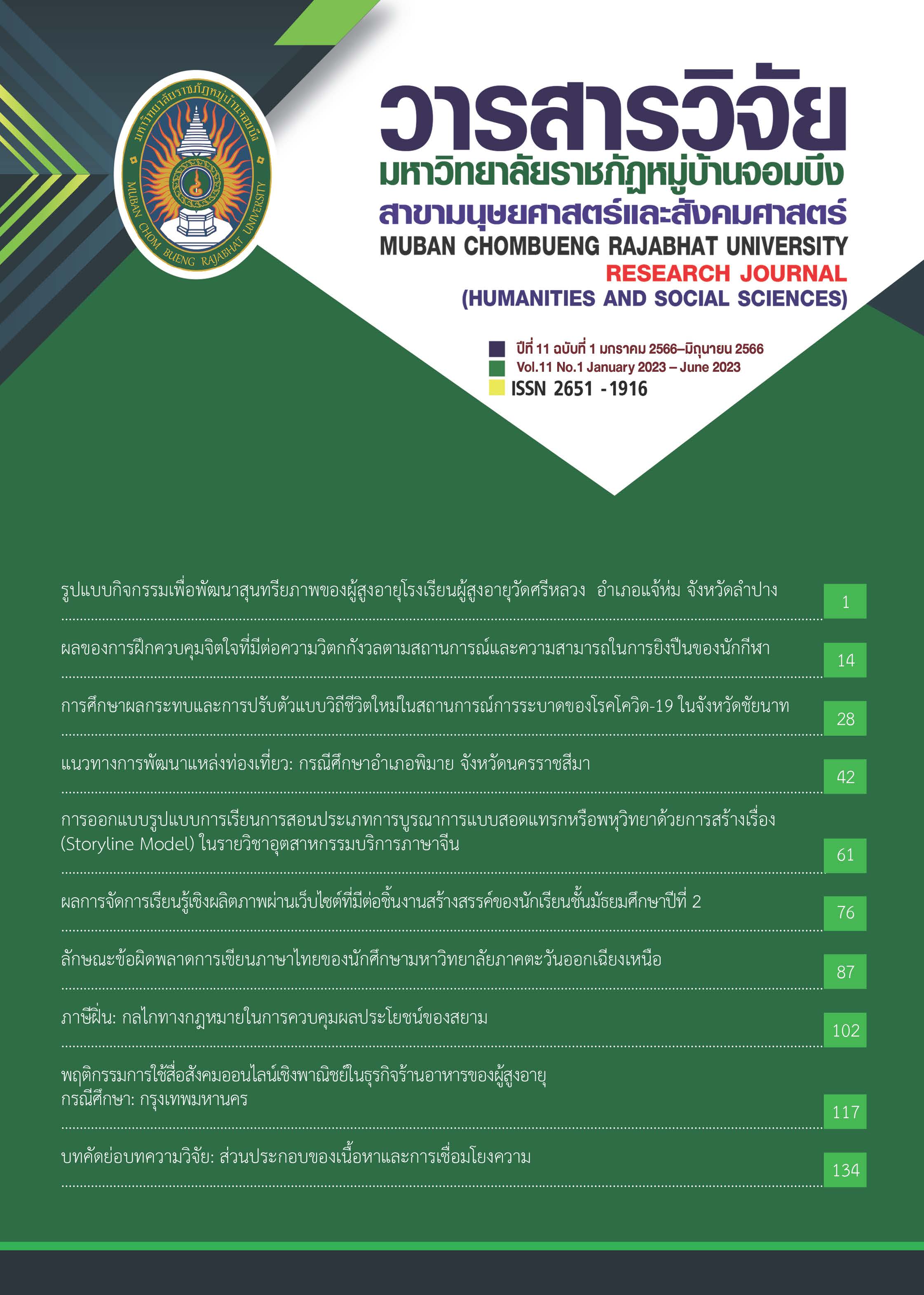การออกแบบรูปแบบการเรียนการสอนประเภทการบูรณาการแบบสอดแทรกหรือพหุวิทยาด้วยการสร้างเรื่อง (Storyline Model) ในรายวิชาอุตสาหกรรมบริการภาษาจีน
คำสำคัญ:
การออกแบบรูปแบบการเรียนการสอน, การสร้างเรื่อง, อุตสาหกรรมบริการด้วยภาษาจีนบทคัดย่อ
งานวิจัยนี้มีวัตถุประสงค์เพื่อศึกษารูปแบบการเรียนการสอนโดยการสร้างเรื่อง (Storyline model) และเพื่อทราบถึงประโยชน์ที่ผู้เรียนได้รับจากผลการนำรูปแบบการเรียนการสอนโดยการสร้างเรื่อง (Storyline model) มาใช้ในการปฏิบัติกิจกรรมบทบาทสมมุติในสถานการณ์จําลอง โดยสํารวจความคิดเห็นและพฤติกรรมการเรียนรู้ของผู้เรียน ในรายวิชาอุตสาหกรรมบริการด้วยภาษาจีน จํานวน 27 คน วิธีการสังเกตวิเคราะห์ข้อมูลเชิงพฤติกรรม การสอบถามรายบุคคล โดยนำเสนอเป็นความเรียง ค่าเฉลี่ย ส่วนเบี่ยงเบนมาตรฐาน ค่าร้อยละ
ผลวิจัยพบว่า 1) การออกแบบรูปแบบการเรียนการสอนโดยการสร้างเรื่อง (Storyline Model) เกิดจากการใช้รูปแบบการจัดการเรียนการสอนแบบบูรณาการ จากจําแนกจํานวนผู้สอน คนเดียว ประเภทการบูรณาการแบบสอดแทรก หรือพหุวิทยา การใช้รูปแบบการสร้างเรื่องมานำเสนอแสดงบทบาทสมมุติ (Role play) โดยกําหนดเส้นทางเดินเรื่องด้วยหัวข้อที่กําหนดขึ้น 2) ประโยชน์ที่ผู้เรียนได้รับจากการออกแบบรูปแบบการสอนประเภทบูรณาการแบบสอดแทรกด้วยการสร้างเรื่อง แบ่งออกเป็น 5 ด้าน ดังนี้ (1) การแสดงออก การพูด กริยาท่าทาง (2) การใช้ภาษาจีนในการสื่อสาร การบริการ ไหวพริบ การแต่งประโยค ความจํา (3) ด้านความมั่นใจ ความกล้า (4) ด้านการทํางานเป็นทีม การวางแผน (5) ด้านความเข้าใจในตัวงานบริการประเภทต่าง ๆ ทั้งนี้ผู้เรียนมีการตอบรับรูปแบบการเรียนรู้นี้เป็นอย่างดี ผู้เรียนมีความคิดเห็นในเชิงบวก ผู้เรียนมีความเห็นว่าเป็นวิธีการที่มีประโยชน์ทั้งด้านความรู้ ความคิดสร้างสรรค์ การประยุกต์ใช้กิจกรรมบทบาทสมมุติมีประโยชน์กับผู้เรียนในการนำมาประยุกต์ใช้กับอาชีพงานบริการในอนาคต ทําให้ผู้เรียนมีความมั่นใจในการพูดมากขึ้น มีความกล้าแสดงออก เข้าใจงานบริการ กล้าที่จะพูดคุยมากขึ้นและประโยชน์ในการนำมาประยุกต์ใช้ในอนาคตหากต้องเผชิญกับสถานการณ์จริงจากความคิดเห็นของผู้เรียนอยู่ที่ระดับมากเท่ากับร้อยละ 66.7
เอกสารอ้างอิง
กิตติพงษ์ เสนาะสรรพ์, &ศุภานันสิทธิเลิศ. (2021). ผลสัมฤทธิ์จากการเรียนรู้ด้านทักษะการสื่อสาร ภาษาจีนโดยใช้รูปแบบ Storyline Model ของนักเรียนชั้นมัธยมศึกษาที่ 5 โรงเรียนสาธิต มหาวิทยาลัยราชภัฏสวนสุนันทา.วารสารการวิจัยการบริหารการพัฒนา, 11(1), 165-174.
จิรชพรรณ ชาญช่าง. (2563). การจัดการเรียนการสอนแบบบูรณาการเพื่อพัฒนาทักษะการคิดขั้นสูง: การเรียนรู้สู่การปฏิบัติจริง. วารสารครุศาสตร์ จุฬาลงกรณ์มหาวิทยาลัย, 48(3), 78-89.
ทิศนา แขมมณี. (2548). ศาสตร์การสอน (พิมพ์ครั้งที่ 4). กรุงเทพฯ: ด่านสุทธาการพิมพ์.
________. (2556). ศาสตร์การสอน: องค์ความรู้เพื่อการจัดการเรียนเรียนรู้ที่มีประสิทธิภาพ. กรุงเทพฯ: โรงพิมพ์แห่งจุฬาลงกรณ์มหาวิทยาลัย.
นำโชค บุตรน้ำเพ็ชร. (2021). การพัฒนารูปแบบการเรียนการสอนซ่อมเสริมแบบผสมผสานด้วยการ เรียนรู้แบบร่วมมือและเทคนิคการสอนโดยการสร้างเรื่องเพื่อส่งเสริมความสามารถในการ เรียนรู้ภาษาจีนของนักเรียนระดับชั้นมัธยมศึกษาตอนปลาย. วารสารอิเล็กทรอนิกส์การเรียน รู้ทางไกลเชิงนวัตกรรม, 11(1), 52-67.
นิภาพร เฉลิมนิรันดร. (2561). การใช้บทบาทสมมุติเพื่อลดความวิตกกังวลในการพูดภาษาอังกฤษในฐานะภาษาที่สอง:กรณีศึกษานักเรียนชาวภูฏานระดับชั้นประถมศึกษาปีที่ 6. วารสารศึกษาศาสตร์มหาวิทยาลัยศิลปากร, 16(2), 223-239.
บุษยากร ตีระพฤติกุลชัย. (2561). การพัฒนาบุคลิกภาพนักสื่อสารโดยใช้กิจกรรมบทบาทสมมุติและกิจกรรมกลุ่มสัมพันธ์. วารสารมหาวิทยาลัยราชภัฏลำปาง, 7(1), 81-98.
พิมพันธ์ เดชะคุปต์ และพเยาว์ ยินดีสุข. (2557). การจัดการเรียนรู้ในศตวรรษที่ 21. กรุงเทพฯ: โรงพิมพ์แห่งจุฬาลงกรณ์มหาวิทยาลัย.
วลัย พานิช. (2543). การสอนด้วยวิธี Storyline. กรุงเทพฯ: โรงพิมพ์แห่งจุฬาลงกรณ์มหาวิทยาลัย.
สนธิ พลชัยยา. (2557). สะเต็มศึกษากับการคิดขั้นสูง. นิตยสาร สสวท, 42(189), 7-10.
สุจินตา คำเงิน ลำไย สีหามาตย์ เกศราพรรณ พันธุ์ศรีเกตุคงเจริญ (2020). การสังเคราะห์ความ รู้ ด้านการจัดการเรียนการสอนภาษาอังกฤษตามแนวคิดบูรณาการเนื้อหาและภาษา (CLIL).วารสารมหาวิทยาลัยราชภัฏร้อยอ็ด, 14(1), 249-260.
สุมิตรา อังวัฒนกุล. (2545). การวิจัยทางการเรียนการสอนภาษาอังกฤษ. กรุงเทพฯ: โรงพิมพ์แห่งจุฬาลงกรณ์มหาวิทยาลัย.
Huang Huan. How to use role playing in junior high school English classroom to improve teaching effect. China-Foreign Exchange,2021,28(3):1431.
Li Ning. (2021). Application research of multimodal theory in teaching Chinese as a foreign language .Master's thesis, Beijing Foreign Studies University.
Livingstone, C. (1983). Role Play in Language Learning. New York: The Printed House.
Medina, J. (2014). Brain rules for baby (Updated and expanded): How to raise a smart and happy child from zero to five. New York: Pear Press.
Shen Yu. Research on the Application of Role Playing in English Teaching. Road to Success,2021(2):130-131. DOI:10.3969/j.issn.1008-3561.2021.02.066.
Yang Xiangnian. On the effect of role-playing teaching method in high school chemistry classroom. Emotion Reader,2021(14):89.
Yin, R. K. (2017). Case study research and applications: Design and methods. Sage publications.
ดาวน์โหลด
เผยแพร่แล้ว
รูปแบบการอ้างอิง
ฉบับ
ประเภทบทความ
สัญญาอนุญาต
ลิขสิทธิ์ (c) 2023 วารสารวิจัยมหาวิทยาลัยราชภัฏหมู่บ้านจอมบึง สาขามนุษยศาสตร์และสังคมศาสตร์

อนุญาตภายใต้เงื่อนไข Creative Commons Attribution-NonCommercial-NoDerivatives 4.0 International License.
วารสาร TCI อยู่ภายใต้การอนุญาต Creative Commons Attribution-NonCommercial-NoDerivatives 4.0 International (CC BY-NC-ND 4.0) เว้นแต่จะรุบุไว้เป็นอย่างอื่นโปรดอ่านหน้านโยบายของเราสำหรับข้อมูลเพิ่มเติมเกี่ยวกับการเช้าถึงแบบเปิด ลิขสิทธิ์ และการอนุญาต



